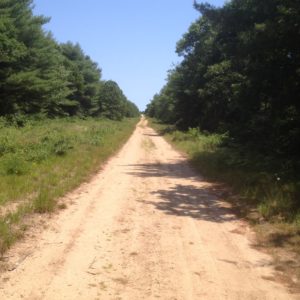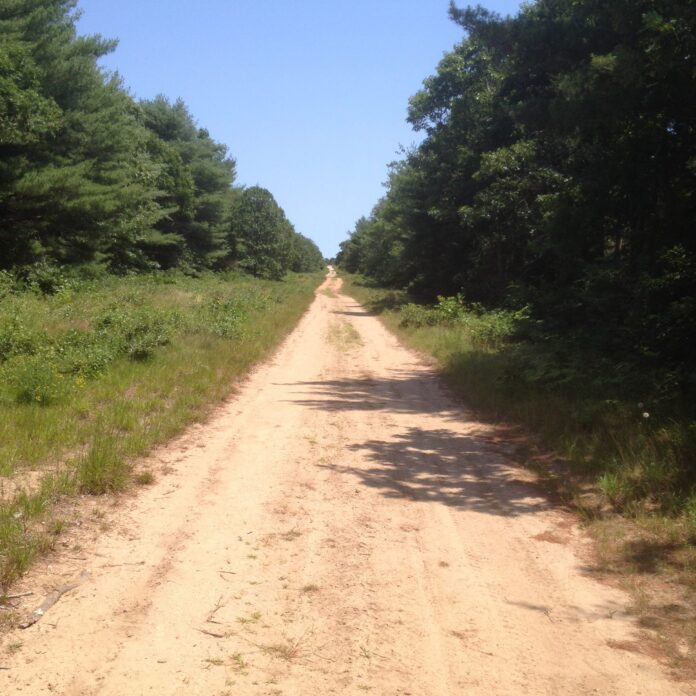The warm sand shifts easily beneath my feet, and pours into my open sandals. A chorus of insects hums a background song as a stiff breeze stirs the greenery around me. The dusty road stretches as far as the eye can see, in a straight line that rolls like a loamy carpet into infinity. I am walking through a forest that most visitors regard as a footnote. Though we expend most of our energy on  the coastline, an entire wild region of the Island is hidden away from view. This central, untamed land is the Manuel F. Correllus State Forest.
the coastline, an entire wild region of the Island is hidden away from view. This central, untamed land is the Manuel F. Correllus State Forest.
Here, a certain sweet smell fills the air at all times. It seeps out of the Scrub Oak and Pitch Pine that make up the majority of the forest. It lends to the forest a certain magical air, as if one has stepped away from everyday life and regressed hundreds of years back in time. To a degree, this feeling isn’t unwarranted. While the rest of the Island has undergone extensive land clearing, this central forest has remained practically untouched for centuries.
Manuel F. Correllus State Forest began as a conservation effort for the endangered Heath Hen in 1908. Unfortunately, the Heath Hen was last spotted in 1932. Since then, the park has been converted into a recreational area, used for biking, hunting, and hiking by the Massachusetts Department of Conservation and Recreation. The forest contains more than fourteen miles of wooded bike paths that stretch through the barrens. The Hen’s demise hasn’t come at the expense of the other inhabitants in the park; many species of rare flora and fauna exist within Correllus, making the centuries-old site a key center for biodiversity on the Island.
The enticing notion of hidden, rare secrets is a theme that pops up repeatedly throughout Correllus. The tangled, dark forest gives off an air of mystery, as if you could visit it a hundred times and still never really understand the forces at play. A straight lattice of fire roads, a little-known feature of human design, crisscrosses through the park. These sandy paths, originally cut through the forest to manage fire outbreaks, provide easy access to the deepest areas of the woods. They bring with them an optical illusion of the archetypical road that goes on forever, and seems to kiss the great blue horizon far ahead in the distance. The roads are the typical way a regular layperson will  experience the park, but unmarked trailheads and forgotten, winding trails branch off into the thick forest.
experience the park, but unmarked trailheads and forgotten, winding trails branch off into the thick forest.
Looking closely, a passerby will discover that another well kept secret bursts from underneath the pine branches. The most common underbrush on the fire roads is not simply grasses and bushes, but wild blueberries and blackberries. They are everywhere. Covering the ground in heavy thickets, hundreds of thousands of low-hanging blueberry plants blanket the forest floor. The ubiquitous, sweet-tart blue fruits are ripe now, in the middle of July, and the joy of finding the little treasures among the leaves is exciting for children and adults alike. But the undomesticated varieties are worlds  apart from the blueberries in your fridge. Because these untamed fruits have no farmer to breed them, a shocking amount of diversity in the berries is present. Some are larger and sugar-sweet, some are shiny, small and tart, some are bright blue, and others jet black. All of them are pretty delicious.
apart from the blueberries in your fridge. Because these untamed fruits have no farmer to breed them, a shocking amount of diversity in the berries is present. Some are larger and sugar-sweet, some are shiny, small and tart, some are bright blue, and others jet black. All of them are pretty delicious.
Eating wild fruit comes with a procedure for safety: make sure the berries have a five-sided crown on top, and research the markings of a genuine blueberry plant before popping them in your mouth. Eat only one at first, and wait a bit. The natural berries are more acidic and harder to stomach than regular, store-bought blueberries. If you can safely get the hang of it, the forest is a natural trove of fun for all ages.
Our lives are filled with an eternal bustle. On an island where thousands swarm the beaches daily and sightseeing busses busily hurdle back and forth, it is hard to imagine a place so genuinely empty. But this place is indeed lost and forgotten. And in this case, maybe that’s not a bad thing. From the time when its ranks of oak and pine were just seeds, this place was always meant to be left untouched. The park is a refuge for those who are caught up in their small daily affairs, and need to lose themselves in something bigger. For anyone that likes a trip off the beaten path. For those of wild heart.
Memory of the dusty road that mingles with the trees and the blue horizon is a constant reminder:
This isn’t our world. We’re just living in it.





